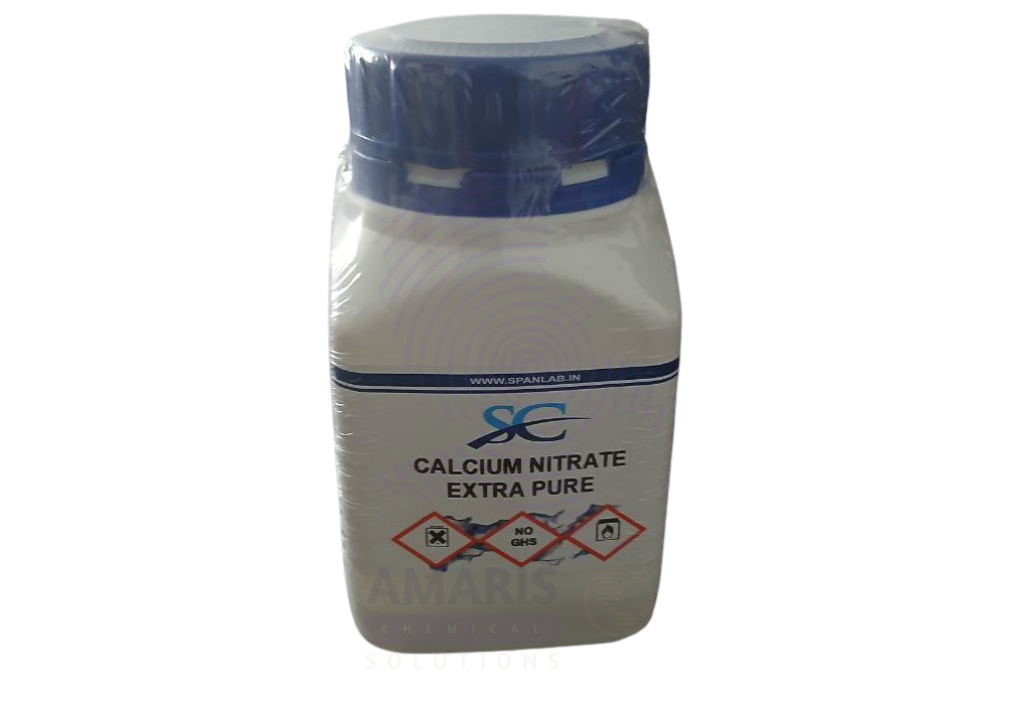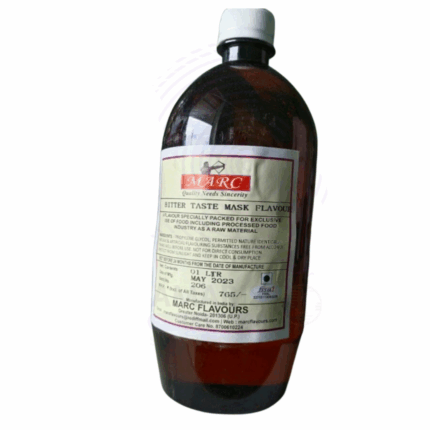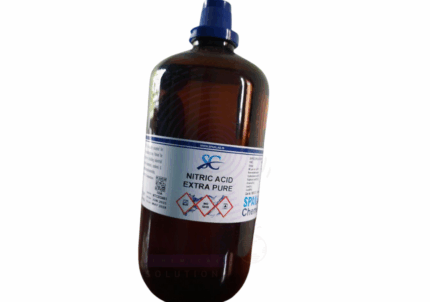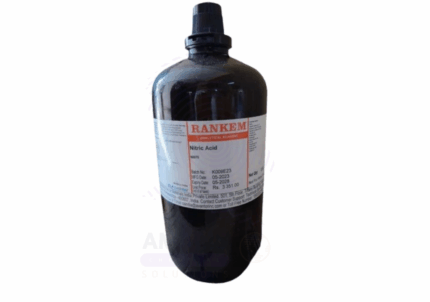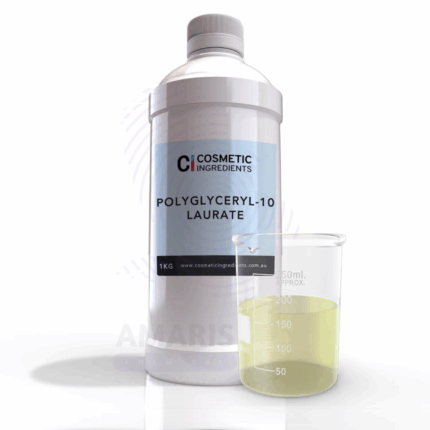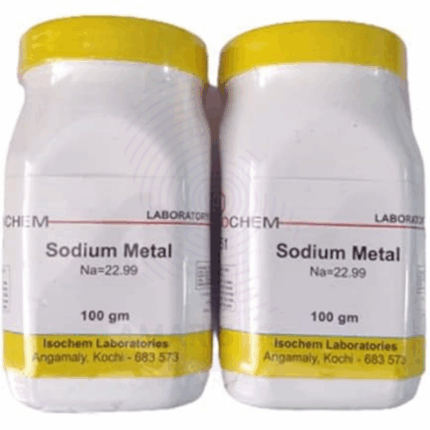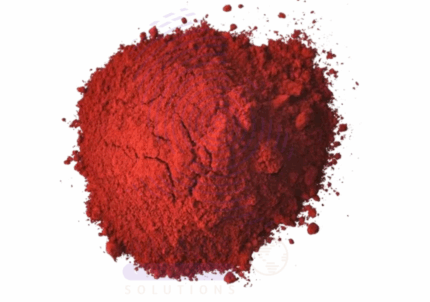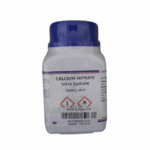
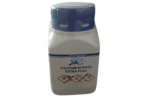
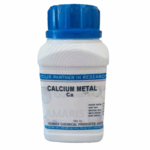
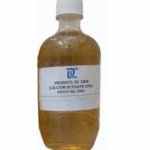
Calcium Nitrate Tetrahydrate Extra Pure
$ 18.11 Original price was: $ 18.11.$ 18.00Current price is: $ 18.00.
Calcium Nitrate Tetrahydrate Extra Pure is a crystalline, highly soluble laboratory-grade compound widely used as a source of calcium ions in analytical chemistry, solution preparation, and coordination studies. Its tetravalent hydrate form allows for controlled moisture content, making it ideal for reproducible experimental setups. This salt is frequently employed in qualitative tests for fluoride and carbonate ions, and in synthesis involving double displacement reactions. In teaching laboratories, it is also used to demonstrate solubility principles and endothermic dissolution behavior. The extra pure quality ensures minimal interference from contaminants, supporting high-precision research and reliable analytical results. It should be stored in a cool, dry environment to prevent caking and preserve its reactivity.
Calcium Nitrate Tetrahydrate Extra Pure
Primary Uses
- Precursor for Calcium-Based Compounds
- Used to synthesize calcium salts (e.g., calcium carbonate, calcium oxalate) by double displacement or precipitation reactions.
- Analytical Reagent
- Serves as a source of Ca²⁺ ions in qualitative and quantitative tests, especially in studies involving ionic equilibria or complexometric titrations.
- Fertilizer Studies in Agricultural Labs
- Used in research labs to simulate or analyze the behavior of nitrate-based fertilizers, especially in plant growth experiments.
- Teaching and Demonstration Experiments
- Employed in solubility and ionic reaction demonstrations in chemistry education settings, showing nitrate solubility and calcium ion reactions.
Secondary Uses
- Heat Pack Reaction Studies
- Involved in endothermic or exothermic reaction investigations due to its dissolution characteristics.
- Electrochemical Research
- Occasionally used in electrolyte formulations or salt bridge solutions due to high solubility and ionic conductivity.
- Synthesis of Coordination Complexes
- Acts as a calcium source in experiments involving the formation of metal-ligand complexes.
| PACK SIZE |
500 grams Plastic Tin |
|---|
1. Basic Identification Attributes
- Chemical Name: Calcium Nitrate Tetrahydrate
- Chemical Formula: Ca(NO₃)₂·4H₂O
- CAS Number: 13477-34-4
- HS Code: 2834.29.90
- Grade: Extra Pure (Laboratory Grade)
- Synonyms: Norwegian Saltpeter, Calcium dinitrate tetrahydrate
2. Physical & Chemical Properties
- Appearance: Colorless, transparent crystalline solid
- Odor: Odorless
- Molar Mass: 236.15 g/mol
- Melting Point: ~45–50 °C (decomposes)
- Density: ~1.82 g/cm³
- Solubility: Highly soluble in water and alcohol
- pH (5% solution): ~4.5–6.5
- Reactivity: Oxidizing agent; may intensify combustion
3. Safety & Hazard Attributes
- GHS Classification:
- Oxidizing Solids (Category 3)
- Eye Irritation (Category 2)
- Hazard Statements:
- H272: May intensify fire; oxidizer
- H319: Causes serious eye irritation
- Precautionary Statements:
- Keep away from heat and flammable materials
- Wear protective gloves and eye protection
- Wash thoroughly after handling
4. Storage & Handling Attributes
- Storage Conditions:
- Store in a cool, dry, and well-ventilated area
- Keep container tightly closed and away from reducing agents
- Packaging: Plastic or glass jars with moisture-resistant sealing
- Handling Precautions:
- Avoid contact with skin and eyes
- Handle in a fume hood if dust is generated
- Prevent contamination with combustible materials
5. Regulatory & Compliance Attributes
- Transport Classification:
- Not classified as a dangerous good under most lab shipping regulations in small quantities
- Disposal Considerations:
- Dilute with water and neutralize before disposal
- Follow local regulations for nitrate-containing waste
6. Environmental & Health Impact
- Toxicity:
- May cause mild irritation on contact with skin or eyes
- Inhalation of dust may cause respiratory tract irritation
- Ecotoxicity:
- Can contribute to eutrophication of water bodies
- Nitrate ions are mobile in soil and can affect groundwater
- Biodegradability: Inorganic; not biodegradable
SAFETY PRECAUTIONS
- Personal Protective Equipment (PPE):
- Wear safety goggles, gloves, and a lab coat.
- Use in a well-ventilated area or fume hood.
- Handling:
- Avoid contact with skin, eyes, and clothing.
- Minimize dust generation and accumulation.
- Avoid mixing with combustible or organic materials — it is a strong oxidizer.
- Storage:
- Store in a cool, dry, well-ventilated area, away from incompatible substances like reducing agents or fuels.
- Keep container tightly sealed and protected from moisture and heat.
FIRST AID MEASURES
- Inhalation:
- Move person to fresh air.
- Seek medical attention if respiratory irritation or symptoms develop.
- Skin Contact:
- Wash skin thoroughly with soap and water for at least 15 minutes.
- Remove contaminated clothing.
- Eye Contact:
- Flush eyes with plenty of water for at least 15 minutes, holding eyelids open.
- Seek immediate medical attention.
- Ingestion:
- Rinse mouth.
- Do not induce vomiting.
- Seek immediate medical attention.
FIRE FIGHTING MEASURES
- Flammability:
- Not flammable by itself but is a strong oxidizer and can intensify fires.
- Extinguishing Media:
- Use water spray, foam, or dry chemical.
- Do NOT use dry combustible materials like sawdust.
- Hazardous Combustion Products:
- May release nitrogen oxides (NOₓ) and calcium oxides when decomposed by fire.
- Firefighter Protection:
- Wear self-contained breathing apparatus (SCBA) and full protective gear.
- Approach with caution and from upwind.


 Preservatives(food)
Preservatives(food) Flavor Enhancers
Flavor Enhancers Acidulants
Acidulants Sweeteners
Sweeteners Antioxidants
Antioxidants Colorants(food)
Colorants(food) Nutraceutical Ingredients (food)
Nutraceutical Ingredients (food) Nutrient Supplements
Nutrient Supplements Emulsifiers
Emulsifiers
 Collectors
Collectors Dust Suppressants
Dust Suppressants Explosives and Blasting Agents
Explosives and Blasting Agents Flocculants and Coagulants
Flocculants and Coagulants Frothers
Frothers Leaching Agents
Leaching Agents pH Modifiers
pH Modifiers Precious Metal Extraction Agents
Precious Metal Extraction Agents
 Antioxidants(plastic)
Antioxidants(plastic) Colorants (Pigments, Dyes)
Colorants (Pigments, Dyes) Fillers and Reinforcements
Fillers and Reinforcements Flame Retardants
Flame Retardants Monomers
Monomers Plasticizers
Plasticizers Polymerization Initiators
Polymerization Initiators Stabilizers (UV, Heat)
Stabilizers (UV, Heat)
 Antifoaming Agents
Antifoaming Agents Chelating Agents
Chelating Agents Coagulants and Flocculants
Coagulants and Flocculants Corrosion Inhibitors
Corrosion Inhibitors Disinfectants and Biocides
Disinfectants and Biocides Oxidizing Agents
Oxidizing Agents pH Adjusters
pH Adjusters Scale Inhibitors( water)
Scale Inhibitors( water)
 Antioxidants(cosmetic)
Antioxidants(cosmetic) Emollients
Emollients Fragrances and Essential Oils
Fragrances and Essential Oils Humectants
Humectants Preservatives
Preservatives Surfactants(cosmetic)
Surfactants(cosmetic) Thickeners
Thickeners UV Filters
UV Filters
 Fertilizers
Fertilizers Soil Conditioners
Soil Conditioners Plant Growth Regulators
Plant Growth Regulators Animal Feed Additives
Animal Feed Additives Biostimulants
Biostimulants Pesticides (Herbicides, Insecticides, Fungicides)
Pesticides (Herbicides, Insecticides, Fungicides)
 Active Pharmaceutical Ingredients (APIs)
Active Pharmaceutical Ingredients (APIs) Excipients
Excipients Solvents(pharmaceutical)
Solvents(pharmaceutical) Antibiotics
Antibiotics Antiseptics and Disinfectants
Antiseptics and Disinfectants Vaccine Adjuvants
Vaccine Adjuvants Nutraceutical Ingredients (pharmaceutical)
Nutraceutical Ingredients (pharmaceutical) Analgesics & Antipyretics
Analgesics & Antipyretics
 Analytical Reagents
Analytical Reagents Solvents(lab)
Solvents(lab) Chromatography Chemicals
Chromatography Chemicals Spectroscopy Reagents
Spectroscopy Reagents microbiology-and-cell-culture-reagents
microbiology-and-cell-culture-reagents Molecular Biology Reagents
Molecular Biology Reagents Biochemical Reagents
Biochemical Reagents Inorganic and Organic Standards
Inorganic and Organic Standards Laboratory Safety Chemicals
Laboratory Safety Chemicals Specialty Laboratory Chemicals(Special Laboratory Equipment)
Specialty Laboratory Chemicals(Special Laboratory Equipment)
 Demulsifiers
Demulsifiers Hydraulic Fracturing Fluids
Hydraulic Fracturing Fluids Scale Inhibitors(oil)
Scale Inhibitors(oil) Surfactants(oil)
Surfactants(oil) Drilling Fluids
Drilling Fluids
 Dyes and Pigments
Dyes and Pigments Bleaching Agents
Bleaching Agents Softening Agents
Softening Agents Finishing Agents
Finishing Agents Antistatic Agents
Antistatic Agents
 Admixtures
Admixtures Waterproofing Agents
Waterproofing Agents Sealants and Adhesives
Sealants and Adhesives Curing Compounds
Curing Compounds Concrete Repair Chemicals
Concrete Repair Chemicals Anti-Corrosion Coatings
Anti-Corrosion Coatings
 Surfactants(cleaning)
Surfactants(cleaning) Builders
Builders Enzymes
Enzymes Solvents (Cleaning)
Solvents (Cleaning) Fragrances
Fragrances
 Electronic Chemicals
Electronic Chemicals Catalysts
Catalysts Lubricants
Lubricants Photographic Chemicals
Photographic Chemicals Refrigerants
Refrigerants Automotive chemicals
Automotive chemicals Pyrotechnic Chemicals
Pyrotechnic Chemicals
 Biodegradable Surfactants
Biodegradable Surfactants Bio-based Solvents
Bio-based Solvents Renewable Polymers
Renewable Polymers Carbon Capture Chemicals
Carbon Capture Chemicals Wastewater Treatment Chemicals
Wastewater Treatment Chemicals
 Pigments
Pigments Solvents(paint)
Solvents(paint) Specialty Coatings
Specialty Coatings Binders/Resins
Binders/Resins Additives
Additives Driers
Driers Anti-Corrosion Agents
Anti-Corrosion Agents Functional Coatings
Functional Coatings Application-Specific Coatings
Application-Specific Coatings
 Fresh Herbs
Fresh Herbs Ground Spices
Ground Spices Whole Spices
Whole Spices Spice Blends
Spice Blends Dried Herbs
Dried Herbs
 Leavening Agents
Leavening Agents Dough Conditioners
Dough Conditioners Flour Treatments
Flour Treatments Fat Replacers
Fat Replacers Decoratives
Decoratives Preservatives(baking)
Preservatives(baking)
 Plasticizers & Softeners
Plasticizers & Softeners Reinforcing Agents
Reinforcing Agents Adhesion Promoters
Adhesion Promoters Vulcanizing Agents
Vulcanizing Agents Antidegradants
Antidegradants Blowing Agents
Blowing Agents Fillers & Extenders
Fillers & Extenders Accelerators & Retarders
Accelerators & Retarders
